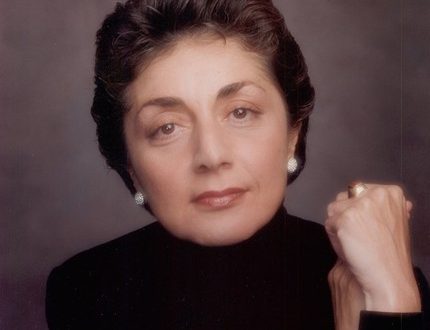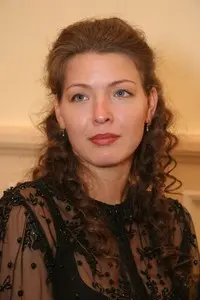
Bella Mikhailovna Davidovich |
Bella Davidovich

…According to family tradition, a three-year-old girl, not knowing the notes, picked up one of Chopin’s waltzes by ear. Maybe so, or maybe these are later legends. But in all cases it is symbolic that the pianistic infancy of Bella Davidovich is associated with the name of the genius of Polish music. After all, it was Chopin’s “lighthouse” that brought her to the concert stage, dawned on her name …
However, all this happened much later. And her artistic debut was tuned to a different repertoire wave: in her native city of Baku, she played Beethoven’s First Concerto with an orchestra conducted by Nikolai Anosov. Even then, experts drew attention to the amazing organicity of her finger technique and the captivating charm of innate legato. At the Moscow Conservatory, she began studying with K. N. Igumnov, and after the death of an outstanding teacher, she moved to the class of his student Ya. V. Flier. “Once,” the pianist recalled, “I looked into the class of Yakov Vladimirovich Flier. I wanted to consult with him about Rakhmaninov’s Rhapsody on a Theme of Paganini and play two pianos. This meeting, almost accidental, decided my future student fate. The lesson with Flier made such a strong impression on me – you need to know Yakov Vladimirovich when he is at his best … – that I immediately, without a minute’s delay, asked to be his student. I remember that he literally fascinated me with his artistry, passion for music, and pedagogical temperament. We note that the talented pianist inherited these traits from her mentor.
And here is how the professor himself recalled these years: “Working with Davidovich was a complete joy. She prepared new compositions with amazing ease. Her musical susceptibility was so sharpened that I almost never had to return to this or that fragment in my lessons with her. Davidovich surprisingly subtly felt the style of the most diverse composers – classics, romantics, impressionists, contemporary authors. And yet, Chopin was especially close to her.
Yes, this spiritual predisposition to Chopin’s music, enriched by the mastery of the Flier school, was revealed even in his student years. In 1949, an unknown student of the Moscow Conservatory became one of the two winners of the first post-war competition in Warsaw – along with Galina Czerny-Stefanskaya. From that moment on, Davidovich’s concert career was constantly on the ascending line. After graduating from the conservatory in 1951, she improved for three more years in graduate school with Flier, and then she taught a class there herself. But the concert activity remained the main thing. For a long time, Chopin’s music was the main area of her creative attention. None of her programs could do without his works, and it is to Chopin that she owes her growth in popularity. An excellent master of the piano cantilena, she revealed herself most fully in the lyrical and poetic sphere: the naturalness of the transmission of a musical phrase, coloristic skill, refined technique, the charm of an artistic manner – these are the qualities inherent in her and conquering the hearts of listeners.
But at the same time, Davidovich did not become a narrow “specialist in Chopin.” Gradually, she expanded the boundaries of her repertoire, including many pages of music by Mozart, Beethoven, Schumann, Brahms, Debussy, Prokofiev, Shostakovich. In symphony evenings, she performs concertos by Beethoven, Saint-Saens, Rachmaninov, Gershwin (and of course, Chopin) … “First of all, romantics are very close to me, – Davidovich said in 1975. – I have been playing them for a long time. I perform quite a lot of Prokofiev and with great pleasure I go through it with students at the Moscow Conservatory … At the age of 12, a student of the Central Music School, I played Bach’s English Suite in G minor at the evening of students of the Igumnov department and received a fairly high mark in the press. I am not afraid of reproaches of indiscretion, for I am ready to immediately add the following; even when I reached adulthood, I almost never dared to include Bach in the programs of my solo concerts. But I not only go through the preludes and fugues and other compositions of the great polyphonist with students: these compositions are in my ears, in my head, because, living in music, one simply cannot do without them. Another composition, well mastered by the fingers, remains unsolved for you, as if you never managed to eavesdrop on the secret thoughts of the author. The same happens with cherished plays – one way or another you come to them later, enriched with life experience.
This lengthy quotation explains to us what were the ways of developing the pianist’s talent and enriching her repertoire, and provides grounds for comprehending the driving forces of her art. It is no coincidence, as we now see, that Davidovich almost never performs modern music: firstly, it is difficult for her to show her main weapon here – the captivating melodious cantilena, the ability to sing on the piano, and secondly, she is not touched by speculative, let and perfect designs in music. “Perhaps I deserve to be criticized for my limited horizons,” the artist admitted. “But I can’t change one of my creative rules: you can’t be insincere in performance.”
Criticism has long called Bella Davidovich a piano poet. It would be more correct to replace this common term with another: a singer on the piano. For for her, playing an instrument was always akin to singing, she herself admitted that she “feels the music vocally.” This is the secret of the uniqueness of her art, which is clearly manifested not only in solo performance, but also in ensemble. Back in the fifties, she often played in a duet with her husband, a talented violinist who died early, Yulian Sitkovetsky, later with Igor Oistrakh, often performs and records with her son, the already well-known violinist Dmitry Sitkovetsky. The pianist has been living in the USA for about ten years now. Her touring activity has recently become even more intense, and she has managed not to get lost in the stream of virtuosos that annually splash out on concert stages around the world. Her “female pianism” in the best sense of the word affects this background even more strongly and irresistibly. This was confirmed by her Moscow tour in 1988.
Grigoriev L., Platek Ya., 1990





